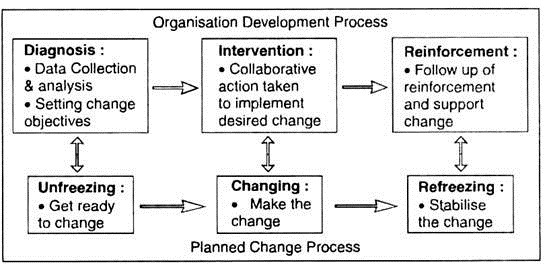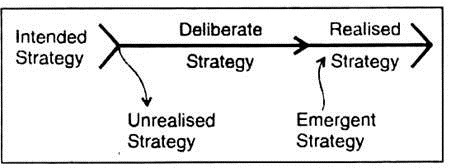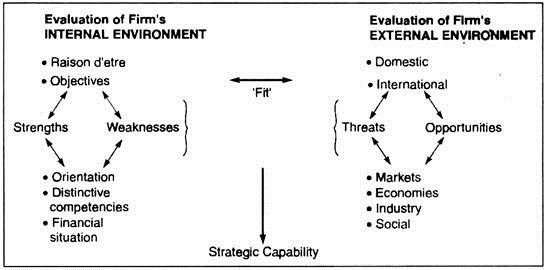The implementation of corporate policies and strategies is an extremely complex problem. It is concerned with the application of various conceptual issues relating to organisation and management. Some of them are: 1. Organisational Structures and Processes 2. Organisation Design and Strategic Factors 3. Strategic Choice of Organisation Design 4. Organisation Development (OD) and a few others.
Conceptual Issue # 1. Organisational Structures and Processes:
The design and management of systems to achieve the best integration of people, structures, processes, and resources are of great impact in reaching organisational purposes. The scope of managerial activities is virtually coextensive with the entire process of management.
ADVERTISEMENTS:
Cannon, one of the management experts, said:
‘Neither strategy nor structure can be determined independently of the other. If structure cannot stand alone without strategy, it is equally true that strategy can rarely succeed without an appropriate structure. Even in large-scale enterprises, well-conceived strategic plans were thwarted by an organisation structure that delayed the execution of the plans or gave priority to wrong set of considerations’.
The basic issues are:
(i) A structure must reflect an organisation’s basic mission, goals and strategic programmes.
ADVERTISEMENTS:
(ii) Organisations must be designed according to the tasks contemplated to be performed.
(iii) The ‘right’ structure for each company at any point in time must consider the determinants like—key factors for success, organisational principles, and management capabilities, styles and personalities.
(iv) The organisational hierarchy coupled with administrative coordination is a source of power and continued growth.
(v) Appropriateness of strategy—’structure-fit’ produces best results (based on the study of U.S. MNCs i.e., multi-product firms with world-wide product divisions).
ADVERTISEMENTS:
(vi) Structure has moved to align itself with strategy, rather than a structure labelled ‘mother-daughter’ as a move towards strategy (based on European studies on multinationals).
(vii) Using a divisionalised structure to implement a multi-product growth strategy is a very effective method of obtaining the desired growth (based on British research in 1980).
Conceptual Issue # 2. Organisation Design and Strategic Factors:
The process of organisation design requires consideration of strategic decision factors as outlined below:
(i) Goals:
ADVERTISEMENTS:
Although different organisations put different emphasis as to their goals on flexibility, growth, efficiency or technical superiority, the relative importance attached to each of them is crucial while selecting an overall structural configuration for the organisation.
(ii) External Environment:
An organisation is always confronted with key questions like: What is the potential for success? How predictable and stable is the environment? Where the organisation faces a few powerful outsiders, the design should help the organisation to target its responses. Conversely, where the organisation faces many powerful outsiders, the design should facilitate frequent adjustments to external demands.
ADVERTISEMENTS:
(iii) Size and Technology:
Growth creates both new opportunities and problems. The design needed for smaller organisations often becomes inadequate with the onset of growth. In hi-tech firms operating on the frontiers of technical development, the design should facilitate technical problem-solving and risk- taking.
Conversely, firms operating with more well-known and stable processes should consider those designs that facilitate efficiency. With the increase in the range of products or services and markets, the organisation design should accommodate differences across those ranges.
ADVERTISEMENTS:
The above viewpoints highlight the contingency approach to organisation design.
The idea is that different organisation designs facilitate different purposes. Thus, the internal functioning of organisations must be consistent with the organisation tasks, technology or external environment, and the needs of its members if the organisation is to be made effective on strategic considerations.
Matrix Organisation design (explained under footnote 4 earlier), a part of organisational dynamics, is found useful ‘in organisations which require responses to rapid change in two or more environments, such as technology and markets, which face uncertainties that generate high-information processing requirements, and which must deal with financial and human resources constraints.’
Conceptual Issue # 3. Strategic Choice of Organisation Design:
Strategy involves the selection of corporate mission and objectives and appropriate courses of action to achieve those objectives. Logically, several courses of action could be identified for any given objective, and for each alternative strategy, an alternative organisation design exists. Thus, specific organisation design should follow from a specified strategy.
ADVERTISEMENTS:
Michael Porter, one of the exponents on corporate strategies, states that corporation can adopt one of three general (generic) strategies stated below, in the realm of organisation design:
1. Cost Leadership:
The organisation design that facilitates overall cost leadership must be one that encourages efficiency and productivity. The system design (bureaucratic or classical or mechanistic) with its emphasis on specialisation, formalisation and centralisation fits this strategy.
2. Differentiation:
That is, the consumers’ perception of uniqueness is based upon a variety of factors, such as brand image, product features, customer service and dealers’ network. The organisation design which facilitates this strategy would tend towards the system design (Non-bureaucratic or neoclassical or organistic) which encourages the freedom of action required by the differentiation strategy.
3. Focus:
ADVERTISEMENTS:
This involves achieving either cost leadership or differentiation or both in a particular segment of the market. The focus strategy implies a trade-off between market share and profitability. This compatible organisation design implies a mix of both system characteristics stated under (1) and (2), because the firm can attempt both cost leadership and differentiation aimed at its segment.
Conceptual Issue # 4. Organisation Development (OD):
There are times when every organisation, or a unit within it, needs to reflect systematically on its strengths and weaknesses—and on the opportunities and threats it faces, particularly in strategic planning process. The concepts and ideas of OD can assist the strategist to do just that.
OD is an exciting application of behavioural science theory to management practices, particularly in a long-range effort to improve an organisation’s ability to cope with change in its external environment and increase in its internal problem-solving capabilities.
It is, thus, a comprehensive approach to improving the overall effectiveness and health of an organisation by making changes in the operations of its component systems.
The principles underlying OD apply to individuals, groups, and organisation. The most important feature is that organisational structures and jobs can be designed to meet the strategic needs of the organisation. They help to identify synergistic solutions to problems with greater frequency. The figure below depicts a general model of OD and shows its relationships to the phase of planned change.
A Simple Case Study:
ADVERTISEMENTS:
For one business firm, the three stages of OD Process were as follows:
1. Diagnosis:
Management perceived a ‘performance gap’ and hired a consultant. The consultant interviewed key people and planned a workshop where the managers should analyse the interview results in a problem-solving format.
2. Intervention:
The workshop was held. The participants were trained on how to analyse the data and determine appropriate action directions; they also received advice on effectiveness of the group process.
ADVERTISEMENTS:
3. Reinforcement:
The consultant continued to meet periodically with the group to review progress; additional help was given when things ‘bogged down’; problem-solving workshops became annual events for the firm.
In the ‘reinforcement’ stage of OD, changes were monitored, reinforced, and evaluated. ‘Refreezing of change’ occurs at this point and this way, the foundations for future replication of similar diagnosis—intervention—reinforcement cycles are set.
Two important points may be noted in this context. Prima facie, receptiveness of organisational members is crucial to the success of OD efforts. Secondly, consent of the governed is required before implementation of any strategies.
Conceptual Issue # 5. Decision Making and Strategy:
Strategy is the end-result of decisions made by those managing the firm. A decision is a specific commitment to action. Strategy may be explicit or implicit. Many firms do not make their strategies explicit. They may express one strategy (an espoused strategy), but follow another course of action (an actual or realised strategy).
So a firm’s strategy can be revealed as ‘a pattern in a stream of decisions’. Sometimes the strategy is planned or intended. Sometimes it just happens or emerges. Sometimes strategy comes to fruition or is realised. Sometimes it remains unrealised. A strategy which is intended and realised ultimately can be referred to as a deliberate strategy.
ADVERTISEMENTS:
The relationships between them is shown below:
Tactical decisions which result in corporate policies with narrower effect on the firm usually involve issues and situations which have been encountered before. Strategic decisions, on the other hand, are those that have not been encountered before in the same form, for which no predetermined response exists in the organisation, and which are important for the growth, stability and survival of the enterprise.
Effective Strategy:
Whether a strategy is explicit or implicit, intended-realised, or unintended-realised does not necessarily determine whether a strategy is effective. An effective strategy is evaluated on the basis of results. In the short-term, financial results are indicators of the firm’s strategic effectiveness.
In the long-term, whether or not the firm met its established objectives is critical. In the very long-term, whether the firm survives as a viable entity is a gauge of its strategic effectiveness.
ADVERTISEMENTS:
How is a firm’s on-going strategy analysed? The answer is found in a strategic audit.
There are at least four broad dimensions which should be covered in any strategic audit, viz.:
(a) Product lines and basic competitive position,
(b) R&D and operating departments,
(c) Financial analysis and financial management,
(d) Top management.
Certain other aspects of this internal review will be identified. For each dimension, past accomplishments, present attainments, and future potential for each area must be considered.
After determination of the firm’s strengths and weaknesses is made, four basic questions need to be answered:
1. How well do the components of this firm’s strategy fit with the opportunities in its external environment?
2. How internally consistent are the components of this firm’s strategy, i.e., how well do they ‘fit’ with each other?
3. Can this firm achieve its objectives?
4. How likely is this firm to survive as a viable entity over the long run?
An internal audit system in the firm is not capable to find the complete answer. There is a need to appraise the external environments of the firm.
Conceptual Issue # 6. Strategic Capability:
The concept of ‘strategic capability’ or ‘strategic fitness’ is an evaluation process—an evaluation of internal and external elements of business environment. Such evaluation is a necessity before making policy decisions or introducing strategic changes.
The basic internal environmental factors are: the firm’s mission and objectives, the firm’s orientation (as revealed by distinctive competencies), and the firm’s financial stability and competencies.
The external elements of business environment are many and varied and unique in characteristics and should include: economic, social, religious, political, technology, industry structure, etc.
How should these environmental dimensions be evaluated? There are no definite set rules. While some evaluation can be quantitative, some qualitative. The present situation compared to the past may provide a clue for this.
However, analysis and evaluation of the internal elements of a firm’s environment must consider the firm’s strengths and weaknesses relative to:
(a) What the firm wants to be or do, and
(b) The threats and opportunities, in the firm’s external environment.
Ultimately, of course, the results the firm will achieve will be determined by the ‘fit’ between the elements of its internal environment and the elements of its external environment. It is this ‘fit’, shown in the diagram below, that determines a firm’s ‘strategic capability’.
Thus, strategic capability may be defined as the capability of an enterprise to successfully undertake action that is intended to affect its long-term growth and development.
In the ultimate analysis, the capability of a firm’s strategy is tested against the key questions (with sub-questions, of course) outlined below:
Is the strategy consistent with environment? Is the strategy consistent with the firm’s internal policies, management styles, philosophy and operating procedures?
Is the strategy appropriate in the light of the firm’s resources? Are the risks in pursuing the strategy acceptable? Does the strategy fit product life cycle and market strength/market attractiveness situation?
Can the firm’s strategy be implemented efficiently and effectively? Are there other important considerations?
Conceptual Issue # 7. Corporate/Organisation Culture and Strategy:
“Organisational cultures are not monoliths. In reality, any complex organisation is a portfolio of cultures, each expressing the ‘rules of the game’ as played by the various groups in the organisation.” Schwartz and Davis, in Organisational Dynamics 1981, observed, ‘Coca-Cola and Pepsi, Hertz and Avis, Mars and Hershey are direct competitors within their industries.
No doubt, their strategies differ significantly. No less doubtfully, so do their companies’ cultures. All one has to do to get a feel for how the different cultures of competing businesses are manifest is to spend a day in each….There are characteristic ways of making decisions, relating to the bosses, and choosing people to fill key jobs’.
A close reading of this advises one to learn how to evaluate corporate culture and how to use it to manage a large organisation through a period of strategic change.
Corporate culture is a pattern of beliefs and expectations shared by the members of an organisation. These beliefs and expectations produce rules for behaviour and norms that powerfully shape the behaviour of individuals and groups in the organisation.
Recent researches in U.S.A. suggest that the primary influence on the behaviour of decentralised profit-centred managers is the behaviour of the top management, which, in turn, reflects their philosophies of management and style of leadership.
It is discovered that culture is capable of blunting or significantly altering the intended impact of even well- thought-out changes in an organisation. A lack of fit between culture and the changes in other aspects of organisation may result in the failure of a new measure to take hold. In this case, either the culture is changed to fit the strategy or the strategy is changed to fit the culture.
The researches further demonstrate that every corporation has a culture (which often includes several subcultures) that exerts powerful influences on the behaviour of managers.
For better or worse, a corporate culture has a major impact on a company’s ability to carry out objectives and plans, especially when a company is shifting its strategic directions. Well-run corporations have distinctive cultures that are somehow responsible for their ability to create, implement, and maintain their leadership positions.
The above researches provide the following methodology for capturing the effects of culture and enabling management to deal with it and its strategy more effectively:
Step 1:
Define the relevant culture and subcultures. Use individual and small-group – meetings. Develop a list of shared beliefs about the way it is.
Feed these back until there is a consensus around the central norms in the culture.
Step 2:
Organise these statements in terms of managers’ tasks and their key relationships.
Prepare a matrix of tasks and relationships that will enable the evaluator to identify cultural traits that place the business strategy at risk.
Step 3:
Assess the risk the company’s culture presents for the realisation of the planned strategic effort.
Categorise those cultural risks into three basic elements: unacceptable risk, manageable risk, and negligible risk.
Step 4:
Identify and focus on those specific cultures that are both highly important to strategic success and incompatible with the organisational approaches that are planned.
Step 5:
Develop alternative organisational approaches that-better fit the existing culture.
(Final) Design planned programmes to change those aspects of culture that are the source of the problem.
To match corporate culture and business strategy, something like the steps outlined above should become a part of the corporation’s strategic planning process.
This sort of culture-risk analysis can help the organisation surface ‘people problems’ before a strategy is implemented, expanding the options how to deal with the most important issues.
Changing a corporate culture is a complex and long-term programme and involves coordinated efforts by the top management leadership. Organisation development process, is a valuable guide in this strategic effort.


